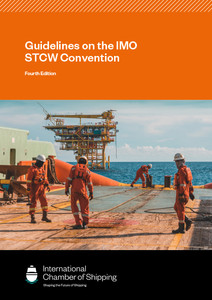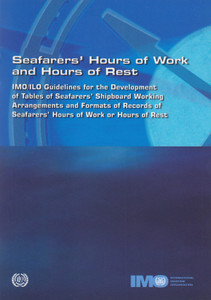
Under the International Convention on Standards of Training, Certification and Watchkeeping for Seafarers (STCW), 1978, as revised in 1995, the ability to use and understand the IMO SMCP is required for the certification of officers in charge of a navigational watch on ships of 500 gross tonnage or more.
The phrases in this publication are divided into Parts A and B. Part A covers phrases to be applied according to the requirements of table A-II/1 of the STCW Code, and may be regarded as the replacement of the Standard Marine Navigational Vocabulary, 1985. This part is enriched by phrases concerning ship handling and safety of navigation to be used in onboard communications. Part B lists other onboard standard safety related phrases which, supplementary to Part A, may also be regarded as useful for maritime English instruction.
As
navigational
and
safety
communications
from
ship-to-shore
and
vice
versa,
from
ship-to-ship
and
on
board
ship
must
be
precise,
simple
and
unambiguous,
there
is
a
need
to
standardize
the
language
used.
This
is
of
particular
importance
in
the
light
of
the
increasing
number
of
internationally
trading
vessels
with
crews
speaking
many
different
languages,
since
problems
of
communication
may
cause
misunderstandings
leading
to
dangers
to
the
vessel,
the
people
on
board
and
the
environment.
In
1973,
the
Maritime
Safety
Committee
agreed,
at
its
twenty-seventh
session,
that
where
language
difficulties
arise
a
common
language
should
be
used
for
navigational
purposes,
and
that
language
should
be
English.
In
consequence
the
Standard
Marine
Navigational
Vocabulary
(SMNV)
was
developed,
adopted
in
1977
and
amended
in
1985.
In
1992,
the
Maritime
Safety
Committee,
at
its
sixtieth
session,
instructed
the
Sub-Committee
on
Safety
of
Navigation
to
develop
a
more
comprehensive
standardized
safety
language
than
SMNV
1985,
taking
into
account
the
changing
conditions
in
modern
seafaring
and
covering
all
major
safety
related
verbal
communications.
At
its
sixty-eighth
session
in
1997,
the
Maritime
Safety
Committee
adopted
the
Draft
IMO
Standard
Marine
Communication
Phrases
(SMCP)
developed
by
the
Sub-Committee
on
Safety
of
Navigation.
The
draft
IMO
SMCP,
following
international
trials,
was
amended
at
the
forty-sixth
session
of
this
Sub-
Committee,
and
was
given
final
consideration
by
the
Maritime
Safety
Committee
at
its
seventy-fourth
session
in
light
of
remarks
received
by
the
Organization.
The
IMO
SMCP
was
adopted
by
the
Assembly
in
November
2001
as
resolution
A.918(22).
Under
the
International
Convention
on
Standards
of
Training,
Certification
and
Watchkeeping
for
Seafarers,
1978,
as
revised
1995,
the
ability
to
use
and
understand
the
IMO
SMCP
is
required
for
the
certification
of
officers
in
charge
of
a
navigational
watch
on
ships
of
500
gross
tonnage
or
more.
Introduction
1 Position of the IMO SMCP in maritime practice
2 Organization of the IMO SMCP
3 Position of the IMO SMCP in maritime education and training
4 Basic communicative features
5 Typographical Conventions
General
1 Procedure
2 Spelling
3 Message markers
4 Responses
5 Distress, urgency and safety signals
6 Standard organizational phrases
7 Corrections
8 Readiness
9 Repetition
10 Numbers
11 Positions
12 Bearings
13 Courses
14 Distances
15 Speed
16 Times
17 Geographical names
18
Ambiguous
words
Glossary
1
General
Terms
2
VTS
special
terms
A1
External
communication
phrases
A1/1
Distress
Traffic
A1/2 Urgency traffic
A1/3 Safety communications
A1/4 Pilotage
A1/5 Specials
A1/6 Vessel traffic service (VTS) standard phrases
Appendix to A1 Standard GMDSS messages
1 Standard
1.1 Structure
1.2 Example
2 Standard urgency message
2.1 Structure
2.2 Example
3 Standard safety message
3.1 Structure
3.2
Example
A2
Onboard
communication
phrases
A2/1 Standard wheel orders
A2/2 Standard engine orders
A2/3 Pilot on bridge
B Onboard communication phrases – operative ship handling
B1/1 Handing over the watch
B1/2 Trim, list and stability
B2 Safety on board
B2/1 General activities
B2/2 Occupational safety
B2/3 Fire protection and fire fighting
B2/4 Damage control
B2/5 Grounding
B2/6 Search and rescue onboard activities
B3 Cargo and cargo handling
B3/1 Cargo handling
B3/2 Cargo care
B4 Passenger care
B4/1 Briefing and instruction
B4/2 Evacuation and boat drill
B4/3 Attending to passengers in an emergency
Procedure for amending the IMO Standard Marine Communication Phrases
Resolution A.918 (22)
A??s a specialized agency of the United Nations, IMO is the global standard-setting authority for the safety, security and environmental performance of international shipping. Its main role is to create a regulatory framework for the shipping industry that is fair and effective, universally adopted and universally implemented. ?
In other words, its role is to create a level playing-field so that ship operators cannot address their financial issues by simply cutting corners and compromising on safety, security and environmental performance. This approach also encourages innovation and efficiency.
Shipping is a truly international industry, and it can only operate effectively if the regulations and standards are themselves agreed, adopted and implemented on an international basis. And IMO is the forum at which this process takes place.
- Number of Pages:
- 0
- ISBN:
- 9789280151374
- Published Date:
- January 2002
- Binding Format:
- Paperback
- Book Height:
- 0 mm
- Book Width:
- 0 mm
- Author:
IMO
- Preview:
- Yes
- Publication Date:
- January 2002






